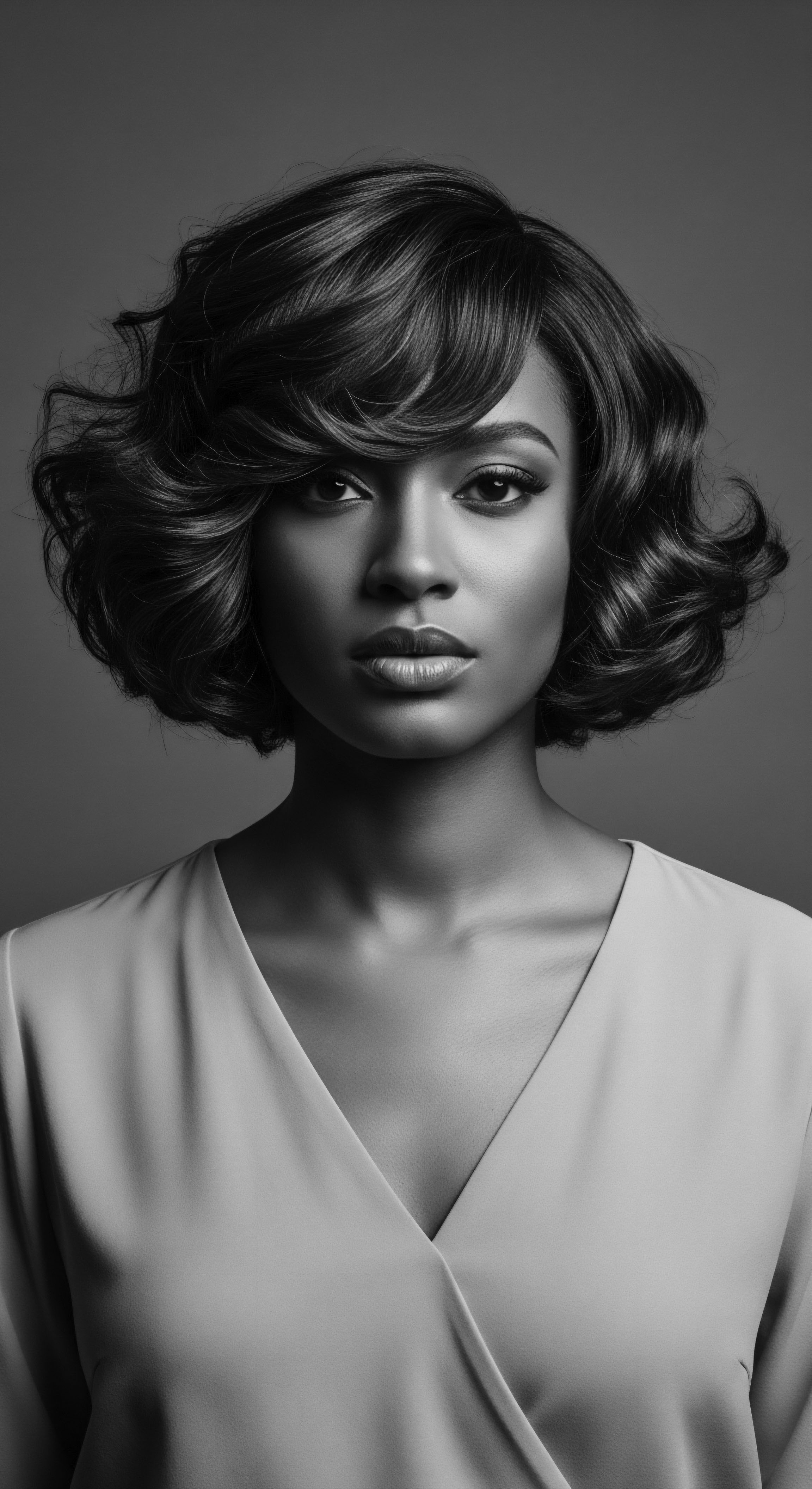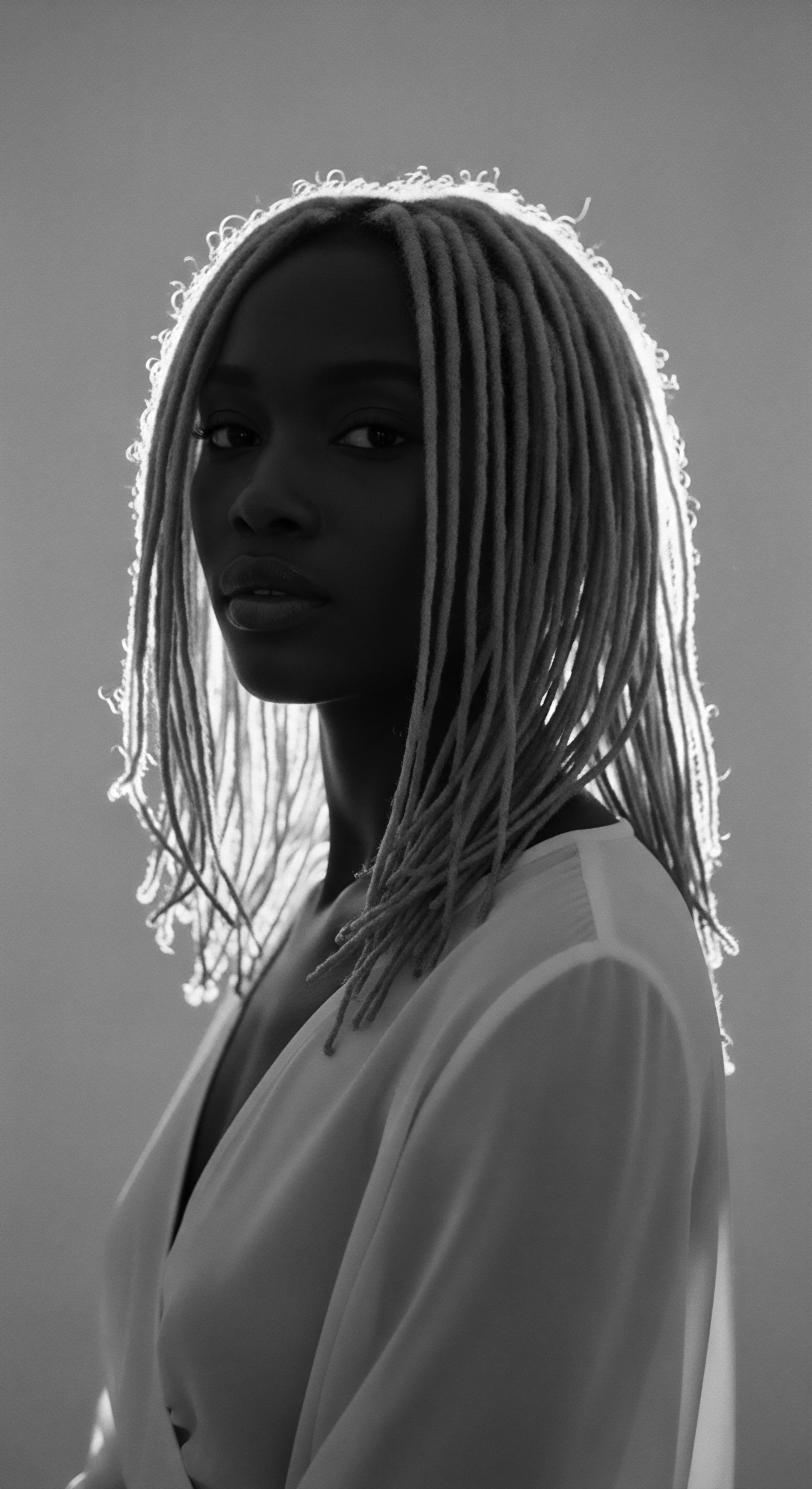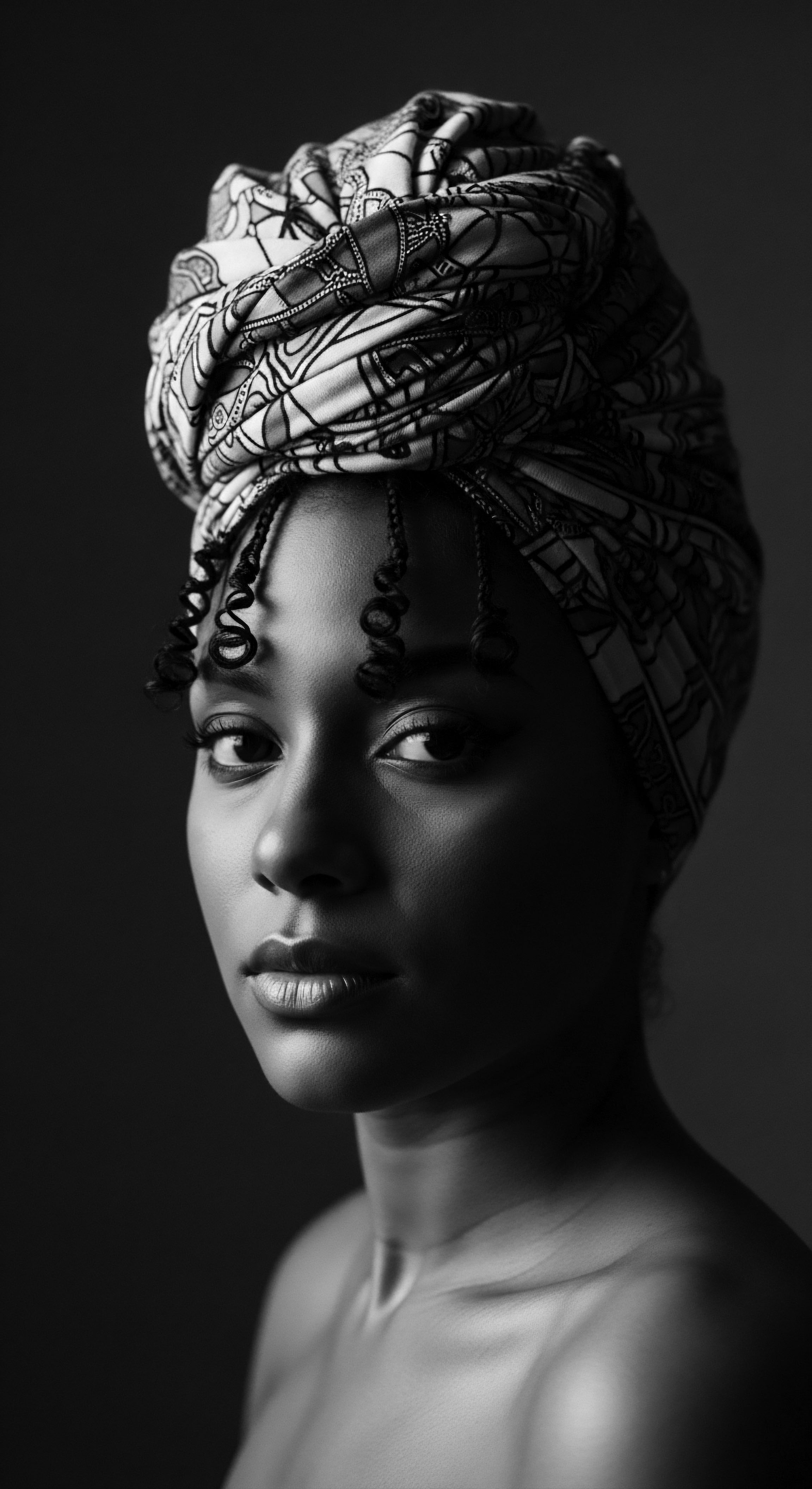The very essence of a strand, a spiraled helix spun from ancient earth and whispered into being by ancestral hands, holds more than mere protein and pigment. It cradles stories, echoes of defiance, and the enduring spirit of a people. For those whose lineage traces through the vibrant tapestries of Black and mixed-race heritage, hair is not a trivial adornment. It is a chronicle, a living archive, and a profound declaration.
To ask how textured hair became resistance is to peer into the soul of identity itself, recognizing that the journey from elemental biology to a symbol of freedom is a deeply personal, yet universally resonant, human narrative. We consider how its innate characteristics, shaped over millennia, laid the groundwork for a language unspoken yet profoundly understood.

Roots
The origins of textured hair, those magnificent coils and curls that crown so many, are etched in the very fabric of human adaptation and ancestry. Across ancient African societies, hair was never a casual detail; it served as a complex system of communication. Before the brutal ruptures of the transatlantic slave trade, hairstyles denoted status, age, marital state, wealth, religious affiliation, and even the tribal identity of an individual. A single glance at a person’s coiffure could reveal their life’s passage, their community ties, and their place within the social order.
This intricate language of locks, often a communal endeavor taking hours or days to craft, fostered bonds and passed down lore. For example, the Yoruba people often used hair braiding as a means to communicate with deities, a testament to the spiritual reverence held for hair.

What Ancestral Wisdom Informed Early Hair Practices?
The deep heritage of textured hair care stretches back through time, informed by a sophisticated understanding of natural elements and their beneficial properties. Our forebears, through generations of keen observation and experimentation, cultivated a rich pharmacopoeia for scalp and strand. They discerned which plants offered cleansing, which imparted moisture, and which provided protection from the elements.
This wisdom, often communicated orally and through practical demonstration, became interwoven with daily life and significant ceremonies. The specific needs of tightly coiled strands—their propensity for dryness due to the helix’s shape, their susceptibility to breakage if mishandled—were understood and addressed with ingenuity.
Consider the Himba tribe of Namibia, whose distinctive hair practices remain a vibrant expression of their enduring heritage. Their traditional use of otjize, a paste of red ochre, butterfat, and aromatic resins, not only offers a striking visual but also serves a deeply practical purpose ❉ it protects the hair and scalp from the harsh sun and insects. This practice, far from being solely cosmetic, is intrinsically tied to their connection to the land and their ancestors.
It illustrates a profound understanding of natural resources for both physical well-being and cultural symbolism. This intricate, protective approach to hair care speaks to an ancestral science, validating the profound efficacy of time-honored rituals.
Ancestral hair practices provided a comprehensive lexicon of identity and well-being, deeply embedded within community life and spiritual connection.
The very structure of afro-textured hair, characterized by its tightly coiled strands and curved follicle, was not merely a biological attribute; it was fundamental to identity, social standing, and societal roles in ancient African kingdoms. These natural attributes were celebrated, seen as symbols of power and beauty. The evolution of this hair type is even theorized to be an adaptation for protecting the scalp from intense ultraviolet radiation, providing natural thermoregulation. This biological truth underscores how textured hair is, at its root, a marvel of natural design, perfectly suited to the environments from which it emerged.
- Shea Butter ❉ Extracted from the nut of the shea tree, this rich emollient has been used for centuries across West Africa for its moisturizing and protective qualities, particularly against environmental damage.
- Castor Oil ❉ Ancient Egyptians utilized this oil for its conditioning and strengthening properties, often mixing it with herbs for hair masks.
- Chebe Seeds ❉ Traditional to Chad, these seeds are roasted and crushed, then mixed with other ingredients like cherry seeds and cloves to create a paste applied to hair, believed to promote length and luster.
- Yucca Root ❉ Indigenous peoples of the Americas used this root to create a natural shampoo, cleansing and nourishing the hair.
| Aspect of Hair Hair as Identity |
| Ancestral Context A system of communication, signifying age, status, tribal affiliation, and spirituality. |
| Colonial Impact Stripped, shaved, or deemed "unruly," forcing an erasure of cultural markers. |
| Aspect of Hair Hair Care |
| Ancestral Context Holistic practices using natural, indigenous ingredients for health and beauty. |
| Colonial Impact Forced use of unsuitable substances, promoting notions of "bad hair" and reliance on chemical alteration. |
| Aspect of Hair Beauty Standards |
| Ancestral Context Celebration of diverse textures as inherent beauty and power. |
| Colonial Impact Imposition of Eurocentric ideals, devaluing textured hair and linking straight hair to social acceptance. |
| Aspect of Hair The shift from reverence to ridicule represents a profound disruption of heritage, yet it simultaneously planted the seeds for hair's role as a tool of defiance. |
The foundational understanding of textured hair, therefore, is not merely biological; it is cultural, historical, and deeply spiritual. It is within these roots that the earliest forms of resistance began to germinate, a quiet but firm refusal to abandon the profound connections woven into each curl and coil. Even when forced to conform, the memory of what hair meant persisted, becoming a hidden wellspring of strength.

Ritual
The rituals surrounding textured hair have long been a tender thread, weaving together individuals, communities, and generations. These practices, passed down through the ages, are more than simple grooming routines; they are acts of profound cultural preservation and quiet rebellion. Each careful comb, each precise braid, each shared story during a styling session becomes a reaffirmation of a heritage that colonial forces sought to dismantle.

How Did Enslavement Transform Hair Practices into Acts of Survival?
With the advent of the transatlantic slave trade, a concerted effort was made to strip enslaved Africans of their identity. One of the first, most brutal acts was often the forced shaving of heads upon arrival in the Americas. This act aimed to erase cultural markers, sever ties to homelands, and dehumanize individuals, a profound assault on their very being.
Despite such horrific attempts at erasure, the inherent significance of hair remained. Enslaved Africans, with remarkable resilience, adapted traditional practices into covert acts of survival and resistance.
Consider the astonishing ingenuity of enslaved rice farmers. They braided rice seeds into their hair before being transported, a silent act ensuring not only personal survival but also the preservation of cultural memory and the potential for a new beginning in a foreign land. This particular historical example, though perhaps less commonly cited than the Afro of the 1960s, powerfully illuminates how textured hair became resistance. It represents a living, breathing archive carried across the Middle Passage, a profound testament to ancestral practices as a source of defiance.
Beyond sustenance, cornrows were also used to create and transmit maps for escape routes from plantations, embedding blueprints of freedom within the very styles of their hair. The geometric patterns, seemingly decorative, held coded messages, guiding those yearning for liberty. This transformed what appeared to be simple adornment into a sophisticated communication system.
Hair rituals, once expressions of community and identity, became vital, clandestine conduits for survival and communication during enslavement.
The maintenance of any hair practices, even under duress, became an act of defiance. The very act of caring for hair, when living conditions afforded little agency, was a reclaiming of self. While access to traditional ingredients was often denied, improvisation became key, utilizing what was available to protect and maintain hair health. This resilience cultivated a deep appreciation for the intrinsic value of textured hair, fostering an enduring bond between hair care and identity, a connection that would reverberate through subsequent generations.

What Legacy do Traditional Styling Techniques Carry Today?
The legacy of traditional styling techniques, refined over centuries, continues to shape contemporary textured hair practices. These styles, originally rooted in practical needs and cultural expressions, now carry layers of historical meaning, serving as visual reminders of resilience and ancestral wisdom. Protective styles, for example, have a long and storied heritage.
- Braids ❉ Dating back 5000 years in African culture to 3500 BC, braids were popular among women and were not just a style but a crafted art form, conveying social status and family background.
- Cornrows ❉ This specific form of braiding, tracing back to 3000 BC, was crucial during the era of enslavement for covert communication and mapping escape routes.
- Bantu Knots ❉ From the Zulu tribe of South Africa, these styles symbolized femininity and beauty, illustrating hair as a canvas for life’s journey.
- Locs ❉ Though their widespread popularity in modern times has varied, locs have ancient roots, with some of the earliest documented instances traced to priests of the Ethiopian Coptic Orthodox Church as early as 500 BCE.
The forced imposition of Eurocentric beauty standards during and after slavery led many to chemical straightening, seen as a path to social acceptance. Yet, throughout history, there has been an underlying current of resistance, a refusal to completely abandon inherited ways. The reemergence of natural styling in movements like the “Black is Beautiful” era of the 1960s and 70s was a powerful rejection of these imposed norms. Icons such as Angela Davis used their Afros as political statements, embodying Black pride and directly challenging the prevailing beauty ideals.
Even today, the return to natural hair and traditional styling practices serves as a form of cultural renaissance, a means for people across the diaspora to reconnect with their roots and challenge dated beauty standards. The continued practice of these ancestral styles is a profound, living testament to the resilience of heritage in the face of persistent societal pressures.

Relay
The journey of textured hair as resistance continues, a dynamic relay race across generations, each passing the baton of defiance and self-affirmation. This ongoing narrative transcends mere aesthetics, becoming a potent symbol of self-determination and cultural sovereignty in an ever-evolving world. The complexities of this journey are a testament to the deep interplay between historical forces, scientific understanding, and the enduring human spirit.

What Societal Pressures Faced Textured Hair in the Past?
For centuries, textured hair has navigated a treacherous landscape of societal pressures, particularly within Western contexts. After the abolition of slavery, the internalisation of Eurocentric beauty standards became deeply ingrained, leading to a pervasive belief that “good hair” meant straight, soft hair, while “bad hair” equated to kinky or coarse textures. This deeply rooted bias impacted perceptions of Black bodies, perpetuating stereotypes that linked textured hair to notions of being “unprofessional,” “unruly,” or “unkempt.” The pressure to conform was immense, often linking straightened hair to social and economic advancement.
The development of chemical relaxers and hot combs provided means to achieve these desired straight textures, yet often at the cost of hair health and a deeper disconnection from ancestral heritage. Madam C.J. Walker, a pioneering Black businesswoman, built an empire providing hair care products that, while aiming to grow and condition Black women’s hair, also facilitated the straightening process, reflecting the prevailing societal demands of the early 1900s. The psychological toll of this constant pressure to alter one’s natural state was profound, fostering a sense of inadequacy within the community that many still work to heal from today.
The historical conditioning of textured hair as “unacceptable” catalyzed a powerful counter-movement rooted in racial pride and self-acceptance.
The institutional bias against textured hair manifested in various forms, from social ostracisation to tangible discrimination in employment and education. Policies, often framed as “race-neutral,” disproportionately affected Black individuals who chose to wear their hair naturally. This systematic devaluation became a powerful catalyst for collective action and advocacy.

How Does Textured Hair Defy Modern Systemic Bias?
The modern natural hair movement, building on the foundations laid by earlier Black liberation movements, stands as a formidable defiance against contemporary systemic bias. It is a conscious rejection of imposed beauty ideals and a vibrant re-affirmation of self-acceptance. This movement, gaining significant momentum in the 21st century, encourages individuals to embrace their natural textures, often seeking to avoid the harmful chemical treatments prevalent in previous eras.
The fight against hair discrimination has moved into legislative arenas. The CROWN Act (Creating a Respectful and Open World for Natural Hair Act) is a testament to this ongoing struggle. This legislation, first passed in Maryland in 2020 and now adopted in numerous states, prohibits discrimination based on race-based hairstyles and hair texture, including braids, locs, twists, and knots. This legislative recognition underscores the severity of the discrimination previously faced and marks a pivotal step toward ensuring legal protection for those who choose to wear their hair in its natural, ancestral forms.
The very existence of such acts speaks volumes about the systemic hurdles still present and the ongoing need for protective measures. The ability to wear one’s hair naturally in professional and educational settings becomes a powerful act of self-ownership and cultural assertion.
The embrace of natural textured hair in contemporary society represents a powerful reclaiming of cultural identity, challenging deeply entrenched discriminatory norms and fostering a renewed sense of collective pride.
Beyond legislative efforts, the defiance extends to cultural and economic spheres. The growth of a dedicated textured hair care industry, focusing on products tailored to the unique needs of curls and coils, signifies a powerful shift in economic agency. This industry provides tools for care that align with the hair’s natural properties, moving away from products designed to alter its fundamental structure.
Moreover, online communities and content creators play a vital role in this relay, sharing knowledge, techniques, and personal journeys, thus reinforcing a collective sense of belonging and empowerment. This digital interconnectedness allows for the widespread sharing of ancestral wisdom, often validated by modern scientific understanding of hair physiology.
The significance of textured hair as resistance continues to deepen, encompassing acts of personal choice, collective advocacy, and cultural celebration. Each individual who chooses to wear their hair in its natural state, or in a protective style rooted in heritage, contributes to a larger declaration ❉ that beauty is diverse, that heritage is strength, and that self-acceptance is a revolutionary act.

Reflection
The story of textured hair, from its genesis in ancient landscapes to its current resonance, truly embodies a profound meditation on the ‘Soul of a Strand’. Each curl and coil, each wave and kink, carries within it not merely the genetic code of an individual but also the indelible imprint of a collective past. It is a living, breathing archive of resilience, a testament to the enduring human spirit that finds voice even in the quiet declaration of a hairstyle. The journey of how textured hair became resistance is a testament to the unbreakable bond between identity and heritage.
This sacred connection transcends time, reminding us that the wisdom of our ancestors, the strength forged in adversity, and the inherent beauty of our authentic selves are not lost to history. They live on, a continuous, luminous thread guiding us towards a future where every strand is celebrated, understood, and honored for the profound narrative it tells. This is the heart of textured hair heritage ❉ a legacy not to be merely observed, but to be felt, practiced, and passed on, ensuring that the echoes from the source will always find their way to the unbound helix.

References
- Byrd, Ayana, and Lori L. Tharps. Hair Story ❉ Untangling the Roots of Black Hair in America. St. Martin’s Press, 2001.
- Ellington, Tameka. “Natural Hair.” Paper presented at various academic conferences, reflecting research on African hair traditions.
- Owens Patton, Tracey. Culture and Customs of Ghana. Greenwood Press, 2006.
- Tharps, Lori L. “Tangled Roots ❉ Decoding the history of Black Hair.” CBC Radio, 2021.
- Kempf, Katherine, et al. “Confronting Hair Discrimination in Schools – A Call to Honor Black History by Protecting Student Rights.” IDRA, 2024.
- Caffrey, Cait. “Afro-textured hair.” EBSCO Research Starters, 2023.
- Matiku, Dafina Nyabhasamba. “The Intersection Between Black Hair and the Environment ❉ Hair as a Site for Environmental Justice and Sustainability.” Senior Thesis, Scripps College, 2021.
- Fox, Taylore. “The Evolution of Black Hair for Beauty & Resistance.” Thrifts & Tangles, 2021.
- Walker, Kara. “A historical journey of the structure, texture, and identity of afro-textured hair.” British Journal of Dermatology, 2024.
- Substack. “Ancestral Hair Rituals to Nourish Your Hair and Soul.” Substack, 2025.
- Afriklens. “African Hairstyles ❉ Cultural Significance and Legacy.” Afriklens, 2024.
- BLAM UK CIC. “The history of Black Hair.” BLAM UK CIC, 2022.
- The Kurl Kitchen. “The Cultural Significance Of Natural Hair In Different Communities.” The Kurl Kitchen, 2024.
- Colleen. “The History of Textured Hair.” colleen, 2020.
- JSTOR Daily. “How Natural Black Hair at Work Became a Civil Rights Issue.” JSTOR Daily, 2019.
